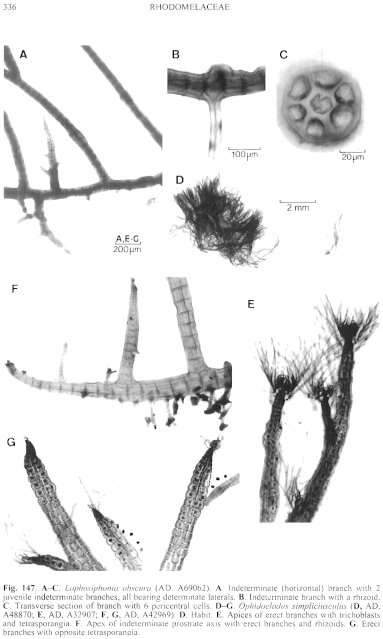|
|
|
|
|
|||||||||||
|
Electronic Flora of South Australia Species Fact Sheet
Phylum Rhodophyta – Family Rhodomelaceae – Tribe Polyzonieae
Selected citations: De Toni 1903: 1072. Falkenberg 1901: 488, pl. 9 figs 16–20. Kylin 1956: 541, fig. 433A–D. May 1965: 381. Saenger 1971: 291, figs 1–8. Silva et al. 1996: 531.
Synonyms
Polysiphonia simpliciuscula Crouan & Crouan 1852; no. 302; 1867: 157, pl. 31, no. 199, 1–5. J. Agardh 1863: 944. Harvey 1863, synop.: xxii. Sonder 1880: 35.
Polysiphonia obscura Harvey 1855a: 541.
Thallus (Fig. 147D) dark brown-red, 2–4 cm high, forming dense mats usually on low-intertidal rock, with prostate indeterminate filaments (Fig. 147F) bearing erect, simple or branched, ecorticate, determinate filaments (Fig. 147E). Attachment of indeterminate filaments by unicellular rhizoids. Structure. Apices of indeterminate filaments curved upwards, dorsiventral, apical cell 25–30 µm in diameter, axes cutting off 10–18 pericentral cells and becoming 130–180 µm in diameter with segments L/D 0.5–1. Erect laterals with conical apical cells 16–28 µm in diameter (including thick walls), producing trichoblasts (Fig. 147E) several segments apart and more-or-less in 2 rows, with 12–22 pericentral cells 12–16 µm broad, surrounding axial cells 40–50 µm broad and L/D 0.8–1.2; filaments (100–) 120–200 µm in diameter, segments L/D (0.3–) 0.5–0.8 (–1). Branching endogenous, frequent from indeterminate filaments, usually sparse from erect filaments. Trichoblasts 0.5–1 mm long, branched from 3–4 basal cells 30–40 µm in diameter and L/D 1–2 (–3), upper cells long. Rhizoids with digitate haptera, cut off from pericentral cells. Cells multinucleate; rhodoplasts discoid to elongate, chained in larger cells.
Reproduction: Gametophytes dioecious, unknown in Australian collections but described by Saenger (1971) from southern Africa. Procarps on the third segment of trichoblasts, developing 5–7 pericentral cells with one (the supporting cell) cutting off a basal and 2 lateral sterile cells and a 4-celled carpogonial branch. Carposporophyte with a basal fusion cell and a branched gonimoblast with clavate terminal carposporangia. Cystocarps ovoid, sessile; pericarp ostiolate, probably ecorticate. Spermatangial organs on lower cells of trichoblasts, reported as 60–300 µm broad.
Tetrasporangia (Fig. 147G) in upper branches, in 2 longitudinal rows of opposite pairs over 6–10 segments, 30–65 µm in diameter, with 2 cover cells similar to pericentral cells.
Type from Anse du Minou, Finistêre, France; holotype(?) in Herb. Crouan, CO; isotype (Crouan 302) in PC.
Selected specimens: Middleton Bay, King George Sound, W. Aust., on sand-covered rocks (Harvey, Feb. 1854; Herb. Harvey, TCD and AD, A18312). Venus Bay, S. Aust., low eulittoral (Womersley, 12.ii.1954; AD, A19513). Cape Carnot, S. Aust., eulittoral (Skinner, 4.xii.1977; AD, A48870). Wanna, S. Aust., low eulittoral (Gordon, 15.v.1968; AD, A32632). Port Elliot, S. Aust., low eulittoral inside breakwater (Venning, 4.ii.1973; AD, A42969). Pennington Bay. Kangaroo I., S. Aust., reef surface (Wickes, 14.iv.1973; AD, A43579). Stanley Beach, Kangaroo I., S. Aust., inner reef (Womersley, 21.xi.1968; AD, A32907).
Distribution: In southern Australia, from King George Sound, W. Aust., to Port Elliot, S. Aust. Western Europe, California, South Africa, Seychelles.
Taxonomic notes: Ophidocladus simpliciusculus appears to be a rare alga on southern Australian coasts, confined to lower eulittoral rock.
References:
AGARDH, J.G. (1863). Species Genera et Ordines Algarum. Vol. 2, Part 3, pp. 787–1291. (Gleerup: Lund.)
CROUAN, P.L. & CROUAN, H.M. (1852). Algues marines du Finistére. Vols 1–3, nos. 1–404. (Brest). Exsiccata with printed labels.
CROUAN, P.L. & CROUAN, H.M. (1867). Florule du Finistêre. (F. Klincksieck: Paris.)
DE TONI, G.B. (1903). Sylloge Algarum omnium hucusque Cognitarum. Vol. 4. Florideae. Sect. 3. pp. 775–1521 + 1523–1525. (Padua.)
FALKENBERG, P. (1901). Die Rhodomelaceen des Golfes von Neapel und der angrenzenden Meeres-abschnitte. Fauna und Flora des Golfes von Neapel. Monogr. 26. (Friedländer: Berlin.)
HARVEY, W.H. (1855a). Some account of the marine botany of the colony of Western Australia. Trans. R. Jr. Acad. 22, 525–566.
HARVEY, W.H. (1863). Phycologia Australica. Vol. 5, Plates 241–300, synop., pp. i-lxxiii. (Reeve: London.)
KYLIN, H. (1956). Die Gattungen der Rhodophyceen. (Gleerups: Lund.)
MAY, V. (1965). A census and key to the species of Rhodophyceae (red algae) recorded from Australia. Contr. N.S. W. Natl Herb. 3, 349–429.
SAENGER, P. (1971). On the occurrence of Ophidocladus (Rhodomelaceae) in southern Africa. J. S. Afr. Bot. 37, 291–304.
SCHMITZ, F. & FALKENBERG, P. (1897). Rhodomelaceae. In Engler, A. & Prantl, K., Die natürlichen Pflanzenfamilien. T.1. Abt. 2, pp. 421–480. (Englemann: Leipzig.)
SILVA, P.C., BASSON, P.W. & MOE, R.L. (1996). Catalogue of the Benthic Marine Algae of the Indian Ocean. (Univ. California Press: Berkeley.)
SONDER, O.W. (1880). In Mueller, F., Fragmenta Phytographiae Australiae. Supplementum ad volumen undecinum: Algae Australianae hactenus cognitae, pp. 1–42, 105–107. (Melbourne.)
The Marine Benthic Flora of Southern Australia Part IIID complete list of references.
Publication:
Womersley, H.B.S. (24 February, 2003)
The Marine Benthic Flora of Southern Australia
Rhodophyta. Part IIID. Ceramiales – Delesseriaceae, Sarcomeniaceae, Rhodomelaceae
Reproduced with permission from The Marine Benthic Flora of Southern Australia Part IIID 2003, by H.B.S. Womersley. Australian Biological Resources Study, Canberra. Copyright Commonwealth of Australia.
Illustration in Womersley Part IIIA, 2003: FIG. 147 D–G.

Figure 147 enlarge
Fig. 147. A–C. Lophosiphonia obscura (AD, A69062). A. Indeterminate (horizontal) branch with 2 juvenile indeterminate branches, all bearing determinate laterals. B. Indeterminate branch with a rhizoid. C. Transverse section of branch with 6 pericentral cells. D–G. Ophidocladus simpliciusculus (D, AD, A48870; E, AD, A32907; F, G, AD, A42969). D. Habit. E. Apices of erect branches with trichoblasts and tetrasporangia. F. Apex of indeterminate prostrate axis with erect branches and rhizoids. G. Erect branches with opposite tetrasporangia.

|
Email Contact: State Herbarium of South Australia |

|